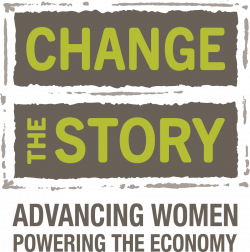Change The Story
After a successful seven years, the Change The Story VT initiative has come to a close.
 Change The Story (CTS) was a multi-year initiative to align philanthropy, policy and program to fast-track women’s economic well-being in Vermont. The work was fueled by three core partners—the Vermont Women’s Fund, the Vermont Commission on Women, and Vermont Works for Women—and was advanced with the help of other critical partners throughout the state in the public, private, and nonprofit sectors. CTS launched in 2015 with a project to collect baseline data related to women’s work, wages, business ownership, and in civic, political, education, and corporate leadership roles, producing 5 status reports. CTS also launched the Business Peer Exchange; the Let’s Talk Gender, Let’s Talk Harassment, and Let’s Talk Race conversation cards; the Male Champions for Change; the Leaders for Equity and Equal Pay cohort and toolkit; and helped coordinate the global #EqualPay soccer jersey phenomenon.
Change The Story (CTS) was a multi-year initiative to align philanthropy, policy and program to fast-track women’s economic well-being in Vermont. The work was fueled by three core partners—the Vermont Women’s Fund, the Vermont Commission on Women, and Vermont Works for Women—and was advanced with the help of other critical partners throughout the state in the public, private, and nonprofit sectors. CTS launched in 2015 with a project to collect baseline data related to women’s work, wages, business ownership, and in civic, political, education, and corporate leadership roles, producing 5 status reports. CTS also launched the Business Peer Exchange; the Let’s Talk Gender, Let’s Talk Harassment, and Let’s Talk Race conversation cards; the Male Champions for Change; the Leaders for Equity and Equal Pay cohort and toolkit; and helped coordinate the global #EqualPay soccer jersey phenomenon.
Change The Story VT: Seven Years of Impact
You can view a snapshot of CTS accomplishments in this short PDF or watch the 14-minute video below about the 7 years of impact, including the creation and evolution of this project, their scope and reach, and the work moving forward. Learn more about the expansive work of CTS: the data reports, the Business Peer Exchange, the free Leaders for Equity and Equal Pay (LEEP) Toolkit to help employers conduct race and gender pay equity reviews, the Let’s Talk Cards, the CTS partnership with the amazing Burlington High School girls varsity soccer team on their #EqualPay campaign, and the work of a cool group of men championing change. We take a walk down memory lane and share more about what new projects were inspired by this work.
Reports
Before Change The Story, access to good data on women’s economic status, wages, and employment, and wages was limited—it was either siloed, unpublished, or not disaggregated by gender. So, CTS developed its own. CTS published five reports: three of them focused on women’s wages, employment patterns, and small businesses, the fourth focused on women’s access to leadership positions, and the fifth an update of the first two (combined). Much of the data in the briefs was either new, or not regularly collected or published. All of the data is specific to Vermont, and all is critical—not just in what it reflects about women, but in its implications for the entire Vermont economy.

